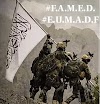Given that 11-12 million people are at risk of starvation in the famine-hit region, an escalation of conflict has huge humanitarian and legal implications. Yet the Western public is being given no oversight on the matter from what appears to be a veritable news blackout on the dire situation.
The New York Times, Voice of America and the Financial Times have this week quoted US and French officials categorically denying any direct involvement in military support of Kenyan forces pushing deep into southern Somalia.
Other Western media outlets are not even carrying reports of credible allegations that American and French forces are waging war in the famine-torn country.
Two senior American officials in Washington cited by The New York Times said that neither the United States military nor the Central Intelligence Agency had carried out airstrikes in Somalia recently.
Voice of America quoted the US State Department claiming: “The United States is not participating in Kenya's current operation in Somalia.”
At most, Washington and Paris are saying that they are offering vague, logistical support. The Financial Times quotes Scott Gration, the US ambassador to Kenya, saying: “We are talking with the Kenyans right now to figure out where they need help.”
In a telling remark indicating self-censorship by the newspaper, the Financial Times noted without further questioning that Gration “did not comment on reports of a series of US drone attacks across southern Somalia in the months since June”.
However, such denials are contradicted by Kenyan and pro-Western Somali military officials who clearly state that American and French forces have bombed Somali civilian centres, including Afmadow, Kismayu and Kadhaa, which have resulted in hundreds of deaths. Kenyan Major Emmanuel Chirchir referring to US drone attacks and French naval bombardment said: “Everybody is in theatre… We know about the strikes. They are complementary.”
On 16 October, Kenya appeared to make a “surprise” invasion of neighbouring Somalia by land, sea and air forces. But 10 days later, with increasing bombardment of towns in Somalia’s southern region, reports of hundreds of civilian casualties and large-scale displacement of people, it is becoming clear that this is no “hot pursuit” cross-border swoop against kidnappers allegedly belonging to the Al Shabab Islamist insurgency – but rather a full-scale war.
The pursuit of kidnap gangs was the pretext given by the Nairobi government for the initial incursion, claiming that Al Shabab militants operating out of Somalia on its eastern border had been responsible for a spate of kidnappings of foreign workers and holidaymakers from Kenyan territory.
Now Kenyan officials are saying that their military campaign will continue until Al Shabab is “flushed out” of all its strongholds – primarily the port city of Kismayu about 500 kilometres south of the Somali capital, Mogadishu.
Three days after the invasion, on 19 October, Global Research reported how “US drones were coordinating air power for the Kenyan ground forces” [1]. Only days before the cross-border incursion, we reported that American unmanned aerial vehicles were involved in attacks on key southern Somali towns and cities in what appeared to be a precursor artillery assault.
The bombardment is now being stepped up, with French naval forces stationed off the Somali coast also involved – the latest killing 59 civilians in Kudhaa, according to Press TV.
Three months ago, the New York Times, Washington Post and The Guardian reported the “extended use of aerial drone attacks” in Somalia when two Al Shabab leaders were targeted for assassination. A month before the Kenyan invasion, both the BBC and Reuters reported on “increasing US drone activity” in the country. Curiously, these same media outlets are either not reporting any such activity – precisely at a time when drone attacks are increasing with devastatingly lethal results – or they are prominently peddling official denials.
It may be noted that the coordinated Western airstrikes in Somalia follows a similar pattern to that conducted in Libya – whereby NATO acted as the air force for anti-Gaddafi militants.
Why the Western media has so far declined to give similar glowing coverage of events in Somalia may reflect the fact that the Kenyan military assault on Somalia is a difficult narrative with which to rally Western public support. Whereas in Libya, the Western media indulged NATO claims of protecting civilians from imminent slaughter under a despotic regime, in Somalia by contrast the pursuit of kidnap gangs does not quite ring true for a cause for war – especially when millions of Americans and French are racked by economic austerity and are being told by their governments that there is no money available to create jobs or fund vital social services.
This public relations problem may be remedied, however, if recent terror attacks in Nairobi can be blamed on Al Shabab. Just last weekend, the US embassy warned of terror threats: 48 hours later two locations in the Kenyan capital were bombed with three dead and dozens of civilians injured. No group claimed responsibility for the atrocities and Kenyan police sources said they had no evidence of Al Shabab involvement. Nevertheless, US officials are now justifying their “intended” support for Kenyan forces in Somalia out a shared objective of “the war on terror”.
Al Shabab has been waging an insurgency against the Transitional Federal Government in Mogadishu, which was installed in 2009 with the support of US and other Western governments as a bulwark against the Islamists. The TFG has only managed to maintain a tenuous grip on power thanks in part to Washington’s military and economic support and to the presence of thousands of African Union troops from Uganda and Burundi. However, large swathes of Somalia, especially in the south, remain under the control of Al Shabab.
Al Shabab is on Washington’s terror list and is accused of having links to Al Qaeda. However, many Western analysts do not consider Al Shabab to be a regional threat. The Council on Foreign Relations, the Washington-aligned think-tank, estimates that the group has only a few hundred hardcore combatants. Nevertheless, the militants have prevented the pro-Western TFG from gaining control of the country. In that way, the group has thwarted Washington and Western geopolitical dominance of the strategically important East African maritime territory.
Recall that the US embarked on a full-scale – and disastrous ¬– military intervention of Somalia in 1992 to salvage its client dictator Siad Barre overthrown by rival warlords. Washington has not managed to regain control ever since despite its backing of an equally disastrous invasion of Somalia by Ethiopian troops in 2006.
With Ethiopia still licking its military wounds and currently facing risk of famine along with its Somali neighbour, perhaps Washington and its French ally have now found another proxy in the form of Kenya to pursue geopolitical aims in Somalia.
Many Kenyans have deep misgivings about their government’s nubile proxy military role. The country is also at risk of famine and its military capability is hitherto untested. Kenyans have noted the way their government launched into Somalia – with which they share much common tribal ancestry – without any public discussion (suggesting orders were taken from Washington and Paris). And they fear that their country could become involved in a bloody regional quagmire that will take human suffering in an already suffering region to untold levels of misery.
Finian Cunningham is Global Research’s Middle East and East Africa correspondent
cunninghamfin@yahoo.com
NOTES
[1] http://www.globalresearch.ca/index.php?context=va&aid=27165







0 Comments